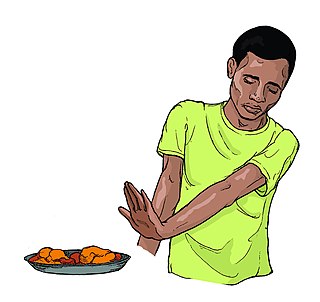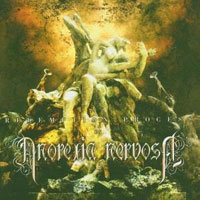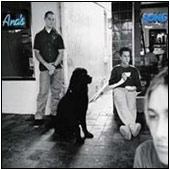Anorexia may refer to:
Anorexia may refer to:

Anorexia is a medical term for a loss of appetite. While the term outside of the scientific literature is often used interchangeably with anorexia nervosa, many possible causes exist for a loss of appetite, some of which may be harmless, while others indicate a serious clinical condition or pose a significant risk.
An eating disorder is a mental disorder defined by abnormal eating behaviors that adversely affect a person's physical or mental health. These behaviors include eating either too much or too little. Types of eating disorders include binge eating disorder, where the patient keeps eating large amounts in a short period of time typically while not being hungry; anorexia nervosa, where the person has an intense fear of gaining weight and restricts food or overexercises to manage this fear; bulimia nervosa, where individuals eat a large quantity (binging) then try to rid themselves of the food (purging); pica, where the patient eats non-food items; rumination syndrome, where the patient regurgitates undigested or minimally digested food; avoidant/restrictive food intake disorder (ARFID), where people have a reduced or selective food intake due to some psychological reasons; and a group of other specified feeding or eating disorders. Anxiety disorders, depression and substance abuse are common among people with eating disorders. These disorders do not include obesity. People often experience comorbidity between an eating disorder and OCD. It is estimated 20–60% of patients with an ED have a history of OCD.
Shining, The Shining or Shinin may refer to:

Bulimia nervosa, also known simply as bulimia, is an eating disorder characterized by binge eating, followed by purging or fasting, as well as excessive concern with body shape and weight. This activity aims to expel the body of calories eaten from the binging phase of the process. Binge eating refers to eating a large amount of food in a short amount of time. Purging refers to the attempts to get rid of the food consumed. This may be done by vomiting or taking laxatives.
Orthorexia nervosa is a proposed eating disorder characterized by an excessive preoccupation with eating healthy food. The term was introduced in 1997 by American physician Steven Bratman, who suggested that some people's dietary restrictions intended to promote health may paradoxically lead to unhealthy consequences, such as social isolation, anxiety, loss of ability to eat in a natural, intuitive manner, reduced interest in the full range of other healthy human activities, and, in rare cases, severe malnutrition or even death.

Appetite is the desire to eat food items, usually due to hunger. Appealing foods can stimulate appetite even when hunger is absent, although appetite can be greatly reduced by satiety. Appetite exists in all higher life-forms, and serves to regulate adequate energy intake to maintain metabolic needs. It is regulated by a close interplay between the digestive tract, adipose tissue and the brain. Appetite has a relationship with every individual's behavior. Appetitive behaviour also known as approach behaviour, and consummatory behaviour, are the only processes that involve energy intake, whereas all other behaviours affect the release of energy. When stressed, appetite levels may increase and result in an increase of food intake. Decreased desire to eat is termed anorexia, while polyphagia is increased eating. Dysregulation of appetite contributes to ARFID, anorexia nervosa, bulimia nervosa, cachexia, overeating, and binge eating disorder.
Binge eating disorder (BED) is an eating disorder characterized by frequent and recurrent binge eating episodes with associated negative psychological and social problems, but without the compensatory behaviors common to bulimia nervosa, OSFED, or the binge-purge subtype of anorexia nervosa.
Muscle dysmorphia is a subtype of the obsessive mental disorder body dysmorphic disorder, but is often also grouped with eating disorders. In muscle dysmorphia, which is sometimes called "bigorexia", "megarexia", or "reverse anorexia", the delusional or exaggerated belief is that one's own body is too small, too skinny, insufficiently muscular, or insufficiently lean, although in most cases, the individual's build is normal or even exceptionally large and muscular already.

Anorexia Nervosa is a French symphonic black metal band from Limoges, formed in 1991. They are currently "on hold" due to the departure of vocalist RMS Hreidmarr.

An underweight person is a person whose body weight is considered too low to be healthy. A person who is underweight is malnourished.
Sexual anorexia is a term coined in 1975 by psychologist Nathan Hare to describe a fear of or deep aversion to sexual activity. It is considered a loss of "appetite" for sexual contact, and may result in a fear of intimacy or an aversion to any type of sexual interaction. The term largely exists in a colloquial sense and is not presently classified as a disorder in the Diagnostic Statistical Manual.

Redemption Process is the fourth album by the French symphonic black metal band Anorexia Nervosa. This album saw a change in lyrical content from lyrics dealing with violence and depression to redemption.

"Ana's Song (Open Fire)" is a song by the Australian alternative rock band Silverchair. It was released in May 1999 as the second single from their third album, Neon Ballroom. The song is about lead vocalist Daniel Johns' struggle with anorexia nervosa. "Ana's Song" peaked at No. 14 on Australia's ARIA Singles Chart, at No. 12 on the US Billboard Modern Rock Tracks chart, and at No. 28 on the Billboard Mainstream Rock Tracks chart. At the ARIA Music Awards of 1999, it was nominated for two awards. The track also earned Silverchair a Comet Award in Germany.
Some claim that the history of anorexia nervosa begins with descriptions of religious fasting dating from the Hellenistic era and continuing into the medieval period. A number of well known historical figures, including Catherine of Siena and Mary, Queen of Scots are believed to have suffered from the condition. Others link the emergence of anorexia to the distinctive presence of an extreme fear of being overweight despite being underweight which emerged in the second half of the 19th century and was first observed by Jean Martin Charcot and other French psychiatrists at the Salpetrière

Nervosa is an album by the band Showbread. It was released on May 13, 2008, simultaneously with its companion album Anorexia. Nervosa second in a two-CD collection entitled Anorexia Nervosa, which is an accompaniment to the short story Anorexia Nervosa which comes packaged within the records. The album acts as a soundtrack to a read-along story book that features a chapter for each track. As the reader follows the story, the album reacts to what happens within the text. Taking a drastic new direction from their second album Age of Reptiles, which featured a more straightforward alternative rock sound, the band took "Nervosa" in a much darker, industrial rock tone.

Anorexia is an album by the band Showbread. It was released on May 13, 2008 simultaneously with its companion album Nervosa. Anorexia is the first of a two-CD collection entitled Anorexia Nervosa, which is an accompaniment to the short story Anorexia Nervosa which comes packaged with the records. The album acts as a soundtrack to a read-along story book that features a chapter for each track. As the reader follows the story, the album reacts to what happens within the text. Taking a drastic new direction from their second album Age of Reptiles, which featured a more straightforward alternative rock sound, the band took "Anorexia" in a much darker, Industrial rock tone.

Anorexia nervosa (AN), often referred to simply as anorexia, is an eating disorder characterized by food restriction, body image disturbance, fear of gaining weight, and an overpowering desire to be thin.
The differential diagnoses of anorexia nervosa (AN) includes various types of medical and psychological conditions, which may be misdiagnosed as AN. In some cases, these conditions may be comorbid with AN because the misdiagnosis of AN is not uncommon. For example, a case of achalasia was misdiagnosed as AN and the patient spent two months confined to a psychiatric hospital. A reason for the differential diagnoses that surround AN arise mainly because, like other disorders, it is primarily, albeit defensively and adaptive for, the individual concerned. Anorexia Nervosa is a psychological disorder characterized by extremely reduced intake of food. People with anorexia nervosa tend to have a low self-image and an inaccurate perception of their body.
Body image disturbance (BID) is a common symptom in patients with eating disorders and is characterized by an altered perception of one's own body.
Atypical anorexia nervosa is an eating disorder in which individuals meet all the qualifications for anorexia nervosa, including a body image disturbance and a history of restrictive eating and weight loss, except that they are not currently underweight. Atypical anorexia qualifies as a mental health disorder in the Diagnostic and Statistical Manual of Mental Disorders (DSM-5), under the category Other Specified Feeding and Eating Disorders (OSFED). The characteristics of people with atypical anorexia generally do not differ significantly from anorexia nervosa patients except for their current weight.